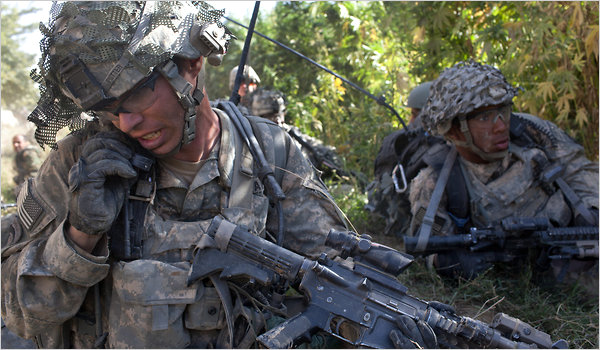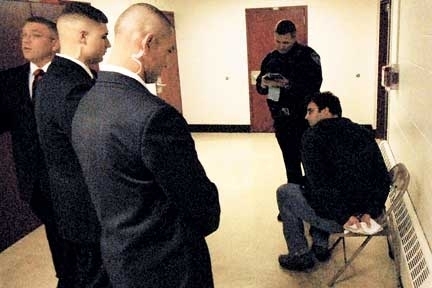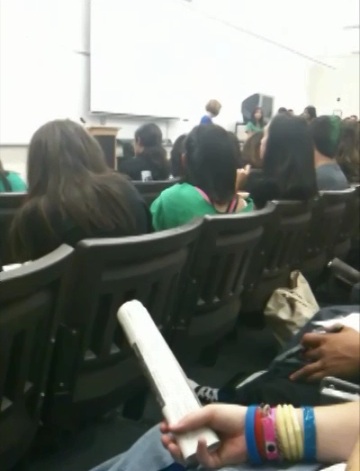Notes
Afghanistan Coverage: I Think We Can Do Better
Today the New York Times reported on a “critical assault” against the Taliban in Afghanistan. There were no photographs in the print edition, and the web version featured only the US commander. I think we can do better.
This photograph was taken recently in Kandahar, although not during the current operation. It stands out because of the strange, almost sacral quality of the man on the pallet. A victim of an IED explosion, he may be raising his head to check on his wounds, or on how he is being maneuvered into the helicopter. Any bump would be likely to hurt, but perhaps he is merely an interested observer of the emergency routine unfolding around him. His hand could even be a gesture of thanks; it’s almost as if we were dispensing a blessing.
Strapped in but not resisting and almost meditative, a simple, partially clothed man with unruly hair surrounded by trained professionals and modern military material, his face darkened by dirt or soot yet illuminated as if in a state of grace, it’s as if he were being transported from some other time and place. As if he were an accidental mummy from human prehistory found in some desert cave, and not one of our allies in the battle against terrorism.
In this second photograph, also taken recently in Kandahar, some of the elements of the first photo have been reversed: now the US soldiers are in the center of the picture and we see their faces, which are the only exposed flesh, as they are before being hit instead of needing medical care, while they are calling for air support instead of already having it, as they are going into battle instead of leaving it. As before, however, the faces are at once arresting and yet don’t quite fit the story. The lieutenant on the radio is focused but not on anything immediately around him, while the soldier in the background, who is looking directly for the enemy, appears both unsure and worried. Neither is looking straight ahead, and because they are so close to the viewer their vulnerability is palpable, as if we could reach forward and swat them.
My point is not that the current attack is going poorly or that war is hell or any other counter-narrative. Instead, note how each photograph doesn’t quite fit into any narrative, positive or negative. Neither tells a story of strategic deployment; in fact, each is obviously a fragmentary episode that only suggests a larger narrative. The man must have been attacked and now is being evacuated, but his image is both enigmatic and disturbing, as if at the scene of an exhumation rather than a rescue. The soldiers must be taking fire while in the field, but it’s not clear whether this is a routine engagement (look at the lieutenant) in Afghanistan or something closer to an ambush in Vietnam (look at the other soldier hemmed in by the thick foliage).
Let me suggest that the value of these images is precisely that they break up the standard narrative of war reportage–a narrative that continually rationalizes war. Here I am drawing on The Face of Battle, by the eminent military historian John Keegan. Contrary to the typical focus by both generals and historians on a reconstructed account of strategic deployment, Keegan set out to learn how warfare turned on the actual details of the ordinary soldier’s experience of battle. How did a horse charge, or an arrow kill? Keegan believed that the answers to such questions could provide an important corrective on the perspective of those who ordered soldiers into battle–a perspective, incidentally, that depends on seeing things from a distance.
It is worth noting that the Times story neatly reproduces the rhetorical design that Keegan identifies in the standard narrative: a critical moment will lead to victory because of a commander’s decision, a simplified characterization that fits together with the uniform behavior of the troops, who move as one according to simplified motivations. You can see for yourself, but suffice it to say that, in the Times’ account, the assault is the “most critical part” of a larger strategy, hundreds of troops move “steadily” and exactly as commanded by General Carter, who expects to know the outcome in 24-48 hours, and nothing is said to indicate any other motivation for “deliberate” military action by the allies and counter-attacks by “insurgents.” The fact that Afghan soldiers have serious effectiveness issues, that the insurgency is growing because of US military action and economic distress, that the success of this operation will be nullified by economic, social, and political realities on the ground–these and similar qualifications will have to be taken up in another article.
The photographs don’t just tell small stories that might be embedded within larger strategic narratives like so many subplots in a TV series. We need to see the face of battle not to fill in the picture, but to be reminded that the story itself may be seriously wrong. And I don’t mean merely the story in the newspaper.
Photographs by David Guttenfelder/Associated Press and Tyler Hicks/The New York Times.



Reactions
Comments Powered by Disqus